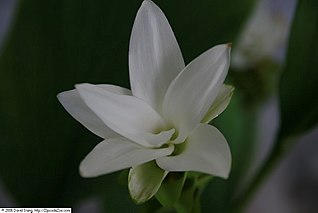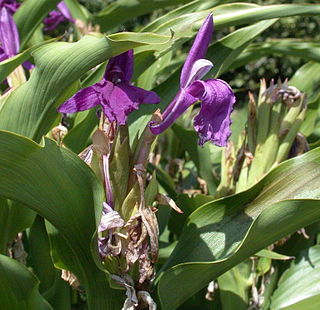
Galangal is a common name for several tropical rhizomatous spices.

Curcuma alismatifolia, Siam tulip or summer tulip is a tropical plant native to Laos, northern Thailand, and Cambodia. Despite its name, it is not related to the tulip, but to the various ginger species such as turmeric. It can grow as an indoor plant, and is also sold as a cut flower.

Curcuma is a genus of about 100 accepted species in the family Zingiberaceae that contains such species as turmeric and Siam Tulip. They are native to Southeast Asia, southern China, the Indian Subcontinent, New Guinea and northern Australia. Some species are reportedly naturalised in other warm parts of the world such as tropical Africa, Central America, Florida, and various islands of the Pacific, Indian and Atlantic Oceans.

Curcuma zedoaria is a perennial herb and member of the genus Curcuma, family Zingiberaceae. The plant is native to South Asia and Island Southeast Asia but are now naturalized in other places including the US state of Florida. Zedoary was one of the ancient food plants of the Austronesian peoples. They were spread during prehistoric times to the Pacific Islands and Madagascar during the Austronesian expansion. Its use as a spice in the West today is extremely rare, having been replaced by ginger, and to a lesser extent, yellow turmeric.

Amomum is a genus of plants native to China, the Indian subcontinent, Southeast Asia, New Guinea, and Queensland. It includes several species of cardamom, especially black cardamom. Plants of this genus are remarkable for their pungency and aromatic properties.

Smithatris is a new genus of the ginger family (Zingiberaceae). The first species of this genus, Smithatris supraneanae, was discovered in 1998 by Kress and Larsen, two researchers from Denmark, in the limestone hills of Saraburi Province, Thailand. The genus was thought to be monospecific until a second species, Smithatris myanmarensis, was discovered later in Myanmar.

Hedychium is a genus of flowering plants in the ginger family Zingiberaceae, native to lightly wooded habitats in Asia. There are approximately 70-80 known species, native to Southeast Asia, southern China, the Himalayas and Madagascar. Some species have become widely naturalized in other lands and considered invasive in some places.

Kai Larsen was a Danish botanist.

Roscoea is a genus of perennial plants of the family Zingiberaceae. Most members of the family are tropical, whereas Roscoea species are native to mountainous regions of the Himalayas, China and its southern neighbours. Roscoea flowers superficially resemble orchids, although they are not related. The flowers of Roscoea have a complicated structure, in which some of the showy coloured parts are not formed by petals, but by staminodes, sterile stamens which have evolved to become like petals. Some species are grown as ornamental plants in gardens.

Cautleya is a small genus of perennial plants of the family Zingiberaceae, found in the eastern Himalayas through to China and Vietnam. It consists of two species of high-altitude tropical and temperate exotic jungle gingers, native to cool forest areas – an unusual habitat for members of the Zingiberaceae. They are grown as ornamental flowering plants.

Etlingera fulgens is a species of herbaceous perennial plant of the Zingiberaceae family. This species occurs in southern Thailand and peninsular Malaysia. Due to its bright red flowers and young leaves, E. fulgens is used as an ornamental plant in landscape gardens.
Riedelia is a genus of plants in the Zingiberaceae family. The genus contains approximately 75 species that are distributed among New Guinea, the Solomon Islands, and Maluku Province in eastern Indonesia. Among the described species is Riedelia charontis, which was formally described in 2010.

Kaempferia is a genus of plants in the ginger family. It is native to China, India, and Southeast Asia.
Geostachys is a genus of plants in the Zingiberaceae. It is native to southeast Asia.
Scaphochlamys is a genus of plants in the ginger family. It is native to Southeast Asia.
Gagnepainia is a genus of plants in the ginger (Zingiberaceae) family. It has three known species, all native to Indochina. All three were initially described in 1895 as members of Hemiorchis, then transferred to the newly created Gagnepainia in 1904.
- Gagnepainia godefroyi(Baill.) K.Schum. in H.G.A.Engler - Thailand, Myanmar, Cambodia
- Gagnepainia harmandii(Baill.) K.Schum. in H.G.A.Engler - Cambodia
- Gagnepainia thoreliana(Baill.) K.Schum. in H.G.A.Engler - Vietnam

Costus curvibracteatus is a tropical rhizomatous perennial native to Costa Rica and Panama. A member of the spiral ginger family of plants, its common name is orange tulip ginger. It is also sometimes referred to as spiral ginger; however, this common name is better associated with Costus barbatus, a more widely cultivated and very similar species. Despite the name and its relation to the ginger family (Zingiberaceae), the rhizomes of the orange tulip ginger are not edible.













